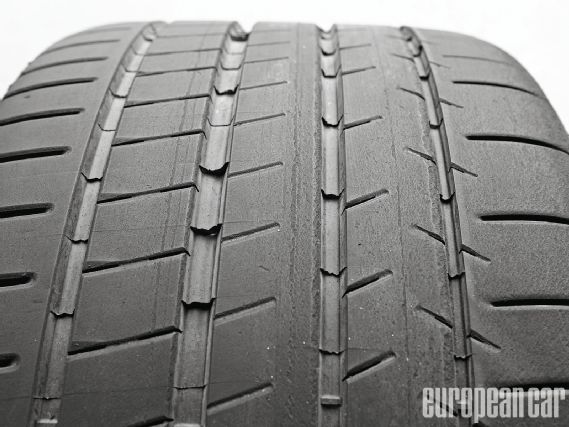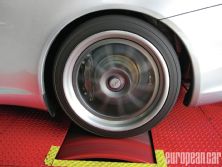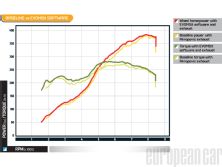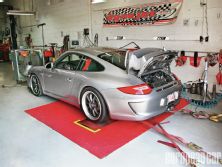 | Project 911 GT3 "T-Rex" - Project Car Part 6 - Proven
| Project 911 GT3 "T-Rex" - Project Car Part 6 - Proven
In this episode, we’ll update you on our most recent GT3 adventures. The first involved the OEM Pirelli tires that had seen lots of action over the past two years. So it was time to shop around for a new street tire that could pinch-hit on wet track days.
It’s our duty to test and report on new tires, but when we saw the specifications on Michelin’s new Pilot SuperSport (PSS) rubber, we actually didn’t bother to look elsewhere.
Michelin’s goals were to improve wet/dry cornering and braking, wear rates, reduce noise and outdo the existing Pilot Sport 2 performance benchmark. To achieve this it incorporated new technologies including Ceinture Twaron, which is a high-density, variable tension fiber belt that provides superior high-speed stability. The belt is tighter in the middle than the shoulders, overcoming centrifugal force and distributing pressure evenly.
The PSS has a bi-compound tread, with the outer section featuring a carbon black-reinforced elastomer to provide maximum grip and longevity, while the inside is for wet and uneven surfaces.
Qualitative street testing revealed excellent grip in wet and dry conditions, crisp turn-in, a smooth ride and it was extremely quiet. Additionally, the tire exhibited almost zero wear after 1000 miles, so we don’t doubt the manufacturer’s “300” wear rating or 30,000 mile warranty.
At my local two-mile, 11-turn racetrack, dry conditions revealed the Michelins were about 1sec slower than laps on R-compound tires, but this put them about 1sec ahead of its comparable street competition.
Cornering g-force was also very good – within 7% of the equivalent R-compounds values.
The UHP Michelin PSS is a superb all-round tire for any condition and, if you only have one set of wheels, they might be the tire to have.
Software
 | Project 911 GT3 "T-Rex" - Project Car Part 6 - Proven
| Project 911 GT3 "T-Rex" - Project Car Part 6 - Proven
In the 7/11 issue, we installed an Akrapovic Evolution exhaust to the car with exceptional results: a weight savings of 37.5 lb, +13whp at the peak, torque gains up to 30 lb-ft, plus a motorsport-inspired soundtrack. However, the downside was a check engine light, signaling inefficient catalytic converters on both cylinder banks.
This was the price of replacing OEM cats with 100 CPI race units and a software remap was probably the only solution. Fortunately, Alex Ross and Dan Kennedy at Sharkwerks in Fremont, CA were following our GT3 project and asked if we’d like to try their EVOMSit software, which could apparently be coded to fix the problem.
Designed for the 997.2 GT3 in a joint venture with Todd Zuccone at Evolution Motorworks in Phoenix, AZ, the Sharkwerks team conducted a great deal of dyno and street testing to ensure good drivability and performance from the product.
The tuning involved a more aggressive fuel map, plus timing advance for automatic switching to specific fuel grades, like the OEM software. So race fuel can be added without the driver risking engine damage by forgetting to manually switch back to the default fuel octane.
In addition, the software can be coded to the driver’s specific needs, such as base octane, sensitivity for O2, disabling
the factory left-foot braking lockout, as well as a more responsive “Sport Pedal” accelerator feature, changing the ratio of pedal movement verses throttle opening.
For our program, we chose 91-octane, O2 sensor sensitivity reduction, left foot braking unlock and OEM throttle response.
The only downside of EVOMSit, is that you need to ship your ECU either to Sharkwerks or an EVOMS dealer for the software to be uploaded. However, Sharkwerks has documented the ECU removal procedure on its website.
When the ECU was returned, the engine seemed perceptibly smoother, with excellent throttle response, no codes and no misfires. Also, the new unlocked left-foot braking code enabled perfect (non-muted) throttle “blips” during heel/toe downshifts since there’s no more throttle cut if the brake is applied.
 | Michelin Pilot SuperSport tires have bi-compound tread and variable tension belts to improve lap times and work well in wet or dry
| Michelin Pilot SuperSport tires have bi-compound tread and variable tension belts to improve lap times and work well in wet or dry
Dyno
We headed to our local dyno shop, RCTS Canada R&D in Calgary, where they again graciously volunteered their time and 248C Dynojet.
The graph compares the OEM software and Akropovic exhaust to the Sharkwerks EVOMSit software plus the Akro.
The results were good for a normally aspirated engine, with the power delivery smoother. The mid-range power and torque couldn’t really be felt, but the car was 3mph faster on the main straight. And while peak power was only up 3whp, notice the whopping 20whp gain at 5400rpm.
Next time, we’ll add some suspension components to our GT3 project car.
Peak wheel power
387whp @ 7800rpm
Peak wheel torque
280 lb-ft @ 5300rpm
Max power gain
3hp @ 7800rpm
Max torque gain
6 lb-ft @ 5300rpm
Pros
- Smoother running
- Fixed engine code
- Left-foot braking enabled
Cons
- You need to ship the ECU for programming



